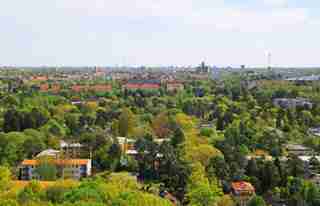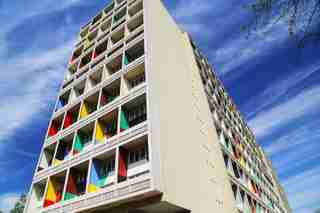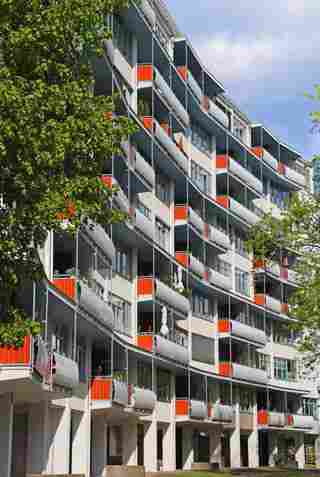If you happen to be in Berlin the next few days for the annual extravaganza called Gallery Weekend Berlin , there’s amazing art to behold at more than 50 participating galleries. But one verdant park in the city’s Hansaviertel district holds a different kind of artistic gem—a grand architectural masterpiece whose appeal has endured for more than five decades. It’s an extraordinary community of modernist apartment buildings, single-family homes, a library, a shopping arcade, and a pair of intriguing churches, all designed soon after World War II thanks to the collaboration of more than 50 of the world’s greatest architects. These starchitects of their time—including Alvar Aalto, Le Corbusier, Walter Gropius, and Oscar Niemeyer—came together to conjure the very best example of postwar urban communal living after World War II. This colorful, strikingly contemporary housing project continues to provide inspiration and ideas to today’s designers. Perhaps the most surprising of all is that some of the original residents still live in the community, which first opened its doors in the late 1950s. One 90-year-old man, who’s been there since the beginning, told me wistfully, “My wife is gone, my health isn’t good, but it’s been the most beautiful place to spend my life.”

A significant feature of the community was that the inhabitants would truly connect with nature in their new homes. This is a view of the park from a balcony of the Le Corbusier–designed Unité d’Habitation of Berlin, a 530-unit high-rise that remains a vital, visually alluring part of the development.

Le Corbusier’s Unité d’Habitation features a graphic, painterly façade. The apartments, which range from one to five bedrooms, feature balconies, airy glass partitions, and views of the surrounding park.

Walter Gropius, founder of the Bauhaus and a pioneer of modern architecture, left Germany before the war, and became the esteemed dean of Harvard’s School of Architecture. He returned to his homeland to participate in the rethinking of Berlin. For the park complex, he created a curved apartment building with a striking layered façade that still looks fresh and inviting today.
The Swedish contribution to this giant complex came from architects Ritz Jaenecke and Sten Samuelson, whose whimsical design features a cheery red façade on one side, a bright blue one on the opposite.
Order and rhythm were integral to Brazilian architect Oscar Niemeyer’s concrete building, designed with 78 apartments. Like most of the estate’s housing, it was lifted off the ground to maintain views of the surrounding park. The angular structure on the left is the fire escape, connected by graceful horizontal bridges.
The forward-thinking (and occasionally controversial) French architect Pierre Vagos fashioned a pure-white residential building with an asymmetrical entry ramp that allowed wheelchair and bicycle access to his apartment block years before regulations became mandatory.
The single-family dwellings incorporated nature in a different, more intimate way. This pristinely modern house was designed by Arne Jacobsen, and features interior and exterior courtyards in which to savor the park setting all year long.
German architect Ludwig Lemmer’s church and square is a central civic structure that brings the community together. Lemmer chose concrete as a material to express form, and created a gentle canopy over the entry of the church. Its bell tower is a point of orientation visible from many places in the park.
